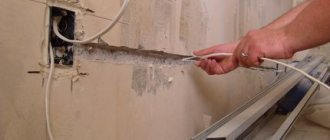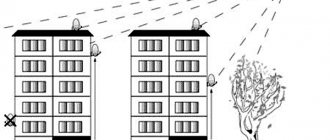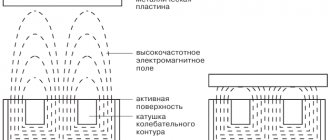Previously, we could only watch in the movies how the hero of the film enters the room, claps his hands and the lights come on. For us, such an action seemed fantastic. Nevertheless, sooner or later any fantastic inventions come to life in real life. And the cotton switch is now gaining more and more popularity. But for most of us, it still remains beyond our understanding and knowledge of electricity. We invite you to take a closer look at this switching device. Find out how it works, what the principle of operation is based on, where to buy it and is it possible to make a similar switch with your own hands?
You can’t yet go in and buy a device like a clap switch at the first electrical goods store you come across. And not every manufacturer of household electrical appliances produces such devices. The most famous company that produces these devices is the Minsk Republic of Belarus. We will study the sound switch using the example of the Ecosvet-X-300-L switch developed by Belarusians.
Application of cotton switch
An acoustic (or clap) switch is designed to control electricity in various rooms remotely, that is, without directly touching the toggle switch. This device works by clapping your hands. In addition to lighting sources, the acoustic regulator can activate contactor coils, current converters, climate control systems and other electrical and electronic equipment - the main thing is that there is enough power.
Acoustic switches in residential areas
Sound switches are optimal for relatively quiet rooms in the house: bedrooms, libraries, offices, pantries, cellars. Installing such a device in the bedroom will allow you not to get out of bed to turn off the lights after you read your favorite book at night and get comfortable under the covers. To make the room plunge into cozy, enveloping darkness, you just need to clap your hands.
Installing a cotton switch in the bedroom allows you to avoid getting out of bed to turn off the lights
It is not advisable to install such devices in noisy places and rooms, since extraneous sounds will regularly provoke unauthorized activation of the device. Therefore, the sound switch is not suitable for office and work areas, kitchens, dining rooms and living rooms.
The cotton switch is very useful in everyday life for people who use a wheelchair, and it will also be useful for children. As a rule, for safety reasons in children's rooms, electrical devices are placed at a height of 1.7 m. In order to independently turn on or off the light, the child has to stand on a stool, and this is also unsafe: the baby may lose his balance and fall. If you install a cotton switch, the child will not ask you to turn on or turn off the light every time. He will simply clap his hands and this will make the light come on or go out.
Interfloor space lighting
Using a clap switch, you can control the light on the area between floors. To do this, it must be equipped with a photo relay. The sensitivity of the motion sensor is controlled by a voltage divider with a resistor creating a photodiode. If using the motion sensor is not essential, you can disable it. To do this, you need to set the resistor to the lowest value.
Using a clap switch, you can control the light on the area between floors
When lighting the interfloor space, you can use the K176LA7 microcircuit. When using it, the automatic electricity activation device does not rattle at the upper and lower levels. Using an electret microphone, an acoustic wave is received and transformed into an electrical impulse. Then, through the use of three-electrode transistors, the pulse is received by the logical sections of the microchip, producing a signal lasting up to 10 seconds. During these 10 seconds, the lamp is in an activated, i.e., on state. To turn it off during daylight hours, you need to send a signal from the element’s output.
Criterias of choice
Before you acquire such a device, you need to determine for what purposes it is needed. On the staircase, in the courtyard and entrance, you can install the most common acoustic sensor that responds to any noise from the surrounding area. This option will allow a person climbing stairs or crossing a darkened area to reach their destination without fear of a blackout. If you install a relay that turns off after a certain period of time, an elderly or slow-walking person will find himself in the dark. The shutdown delay can be adjusted if it is provided by the manufacturer, or design changes can be made to an already purchased device.
There are other requirements for devices of a certain type:
- the street sensor must be reliably strengthened and equipped with protection from natural influences (this is especially important in regions with problematic climates;
- if the purpose of the purchase is to save lighting, it is better to purchase a model equipped with a photo relay
- the principle of operation of a dimmer acoustic switch is useful in a personal plot, in a country house - the lighting will turn off as soon as the external space no longer needs additional light, but it is also useful where people leave the room for a short time and return again (in the kitchen, in the production workshop ;
- the range of action is important if you plan to control a large space; for apartment conditions, the minimum indicators are sufficient.
Sometimes in reviews of such products you can find insistent assurances about the need to purchase sensors from a branded manufacturer with a proven reputation and high cost. At home, you can perfectly use homemade sensors that you assemble yourself. If you have no knowledge on this issue, you can simply buy a reliable domestic device.
Video: how to assemble a cotton switch sensor with your own hands
How does an acoustic switch work?
The operating procedure of the cotton device is very simple: the first clap turns on the load, the second turns it off. A fairly sensitive microphone receives an acoustic wave and sends it in the form of a signal to an audio frequency power amplifier. Next, the intense signal reaches the base of the switch, the value of which allows you to activate the transistor. The moment the base of the switch receives a pulse, the electron-hole junction of the transistor opens and conducts an electric current that powers the connected lighting fixture or relay that controls the loads.
An acoustic (sound) switch and a clap switch are not exactly the same thing. The acoustic (sound) sensor is triggered by any sounds and noises, and the cotton sensor is triggered only by clapping your hands. Thus, we can say that the clap switch is a type of acoustic (sound) switch.
Electrical engineer Dmitry, author of the site "Electrician's Notes"
https://zametkielectrika.ru/xlopkovyj-vyklyuchatel/
Tests
Before turning on the device, you should configure it to eliminate false alarms due to extraneous sounds. For example, a cotton device should not respond to the blows of a hammer, the knocking of dishes, a ringing telephone, or a switched-on hammer drill.
Settings are made experimentally. The device is considered configured when it responds only to claps.
Technical characteristics of the cotton device
Light switches that are activated by clapping sounds can be found commercially or you can make your own. Let's consider the device "Ekosvet-X-200-L", produced by the Belarusian company. It has the following technical characteristics:
- load power - up to 300 watts;
- sound intensity - 30–150 decibels;
- mains voltage - 220 volts.
Cotton switches "Ekosvet-X-300-L" are designed to turn lighting on and off using a loud and ringing sound
In addition to the switch itself, the kit includes a box and installation instructions. The price of this switch in comparison with similar devices from other manufacturers is quite affordable. The switch is produced in a protective housing class IP-30. It can operate at temperatures from -20 °C to +40 °C. This device can be combined with virtually any lamps: halogen, fluorescent, energy-saving, LED and standard incandescent lamps. The device is no larger than a matchbox, so it can be easily placed at the base of any light source. The switch is attached using double-sided construction tape or self-tapping screws.
Components of a sound switch
You can mount the acoustic switch yourself. Let's give an example using domestically produced KT315 transistors in a microphone amplifier. The final stage uses a high-power transistor switch based on the KT818 bipolar transistor. If you intend to control lamps with a power supply above 12 volts, then a relay is needed in the circuit. If the expected loads are less than this value, then the relay can be deleted. Copper wires are connected using Wago 222 terminals, which have their pros and cons.
Copper wires can be connected using Wago terminals
Advantages of Wago terminal blocks:
- speed, accuracy and ease of connecting wires;
- electrical safety;
- no need to use special electrician tools;
- reliability;
- aesthetics and beauty.
Disadvantages of Wago terminal blocks:
- high price;
- The location of the nest is not very convenient.
Electrical diagram
There are many options on the Internet of varying complexity depending on the configuration, but not all of them are functional. Defects appear during manufacturing. The presented electrical circuit has been tested in practice.
Here VD1 is intended to protect transistor VT3. To use the relay, a diode must be installed. If you decide to install a light load, we recommend replacing the diode with a jumper.
Step-by-step instruction
The acoustic module itself is glued with tape from the inside to the chandelier or the body of an electrical appliance; connections are easier to make with Wago-type terminal blocks:
- de-energize the network, break the power circuit going to the key switch, remove the insulation and strip the ends of the wire;
- a pair of white wires from the acoustic module are connected to the phase and neutral coming from the shield or junction box;
- The two remaining black wires are similarly connected to the terminals of a lamp or household appliance.
All that remains is to move the button of the conventional switch to the “on” position, the system is ready for operation.
Operating principle of an acoustic dimmer switch
An optical-acoustic switch is used for dimmer switching on electricity. It works as follows:
- The sound signal (in our case it is a clap) arrives at the sensitive membrane of the microphone. There the sound is converted into an electrical impulse. When passing through the operational amplifier, the pulse power increases and the capacitor is charged. When the charge reaches a higher value than on the capacitance, the comparator switches. In this case, the zero at the output is replaced by a pulse from the logical section.
- Such a chain is sequentially activated in the switch after receiving an acoustic signal from the microphone. Then the transistor generator is started, directing the electrical impulses, and the triac opens. Through it, power is supplied to the light source.
- After some time, the capacitor loses voltage level. In this case, the triac receives control electrical signals with an ever-increasing phase delay, as a result of which the light turns off smoothly. With optimal selection of values, the light source turns off with a pause of up to three minutes.
An optical-acoustic switch is used to switch on electricity by dimmer
Manufacturers
The most famous models presented on the Russian market are “Ecosvet” and “Claps”. Let's look at their main characteristics.
Switch "Сlaps"
One of the newest developments is the “Claps” cotton switch model. In this device, the sound is processed using a microprocessor; it does not react to any extraneous noise, but is tuned to several claps in a row (this is the most important operating condition).
It is permissible to install several such switches in one room, each of them will react to a certain number of claps, and accordingly turn on the light, humidifier, fan, TV or stereo system. This switch model is suitable for any household appliances that have an electrical cord.
Perhaps to some, the clap switch may seem like a toy or a completely unnecessary device. Others, on the contrary, are passionate about the idea of creating their own “smart home” so that lights and electrical appliances turn on and start working on command or clap. Arrange your life the way you want, but at the same time make it as comfortable as possible.
Ecolight switch
The Ecosvet device is designed to work with 220 Volt light bulbs.
Main parameters of the device:
- load - 300 Watt;
- sound signal spread - from 30 to 150 decibels;
- housing protection level - IP30;
- permissible temperature range - from 20 degrees below zero to 40 degrees above zero;
- cost - from 350 rubles.
“Ekosvet” is fixed with self-tapping screws using the mounting legs. It is not recommended to install the device in noisy rooms. Despite the fact that “Ekosvet” is configured to clap, false alarms are possible.
The figure above shows the device connection diagram. "Ecolight" is connected to a conventional switch to provide the ability to de-energize the circuit and stop its operation.











